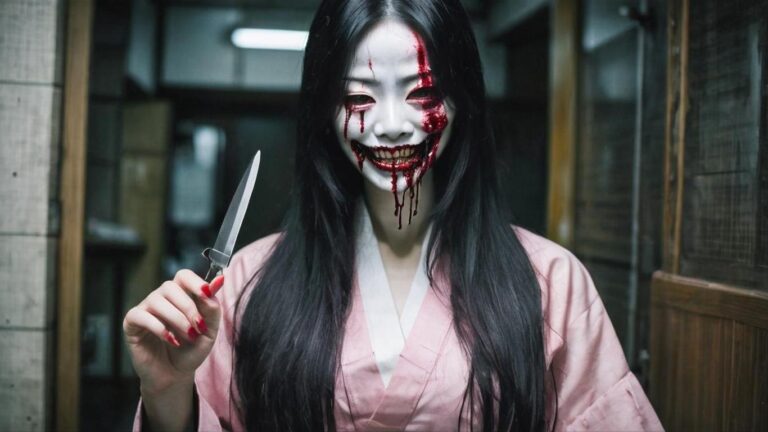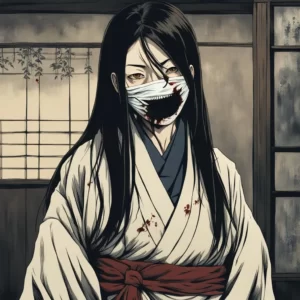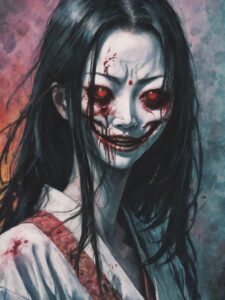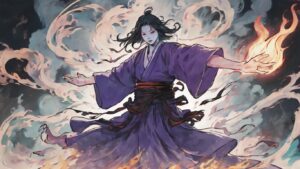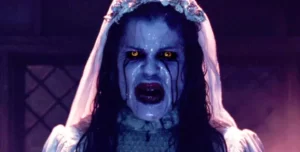Table of Contents
The legend has different variations, and there are different accounts of how to escape or deal with Kuchisake-onna. Some versions suggest answering her question ambiguously or distracting her to escape, while others propose giving her candies or money. The story has been adapted in various forms of media, including movies, books, and even video games. It’s important to note that Kuchisake-onna is primarily a folklore figure and not based on any historical events or real-life occurrences.
Origins
One theory suggests that the legend may have been inspired by historical events, such as the widespread use of surgical masks in Japan during the flu epidemic in 1918. During that time, it became common for people to wear masks to protect themselves from the flu, and this may have contributed to the eerie imagery of a woman wearing a surgical mask.
Another theory proposes a connection to traditional ghost stories or supernatural tales in Japanese folklore. Stories of vengeful spirits or yūrei (ghosts) with disfigured features are not uncommon in Japanese culture.
The exact origins remain uncertain, but Kuchisake-onna has become a prominent figure in Japanese urban legends, and her story continues to capture the imagination through various adaptations in popular culture. The legend has also spread beyond Japan and gained international recognition, further contributing to its mysterious and enduring appeal.
Variations of the legend
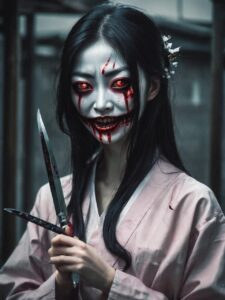
The legend of Kuchisake-onna has evolved over time, and various regions in Japan and other parts of the world may have different versions of the story. Here are a few variations of the Kuchisake-onna legend:
Historical Origins: Some versions of the legend suggest that Kuchisake-onna was a real person, a woman who lived in feudal Japan. According to this variation, she was either a samurai’s wife or a courtesan who was disfigured as a form of punishment or revenge.
Modern Urban Legend: In the more modern and well-known version, Kuchisake-onna is often described as a contemporary woman who fell victim to a violent act, leading to her disfigured mouth. She then returns as a vengeful spirit.
The Candy Solution: In some versions, there’s a way to escape harm from Kuchisake-onna. The legend suggests that if you offer her candy or sweets, she might spare you. This element has led to the belief that carrying candy can be a form of protection.
Ambiguous Answer Escape: Another strategy to avoid harm is to respond to her question with an ambiguous answer. Some versions suggest that confusing her with responses like “You are average” or “So-so” may allow you to escape unharmed.
Ghostly Pursuit: In certain versions, Kuchisake-onna is said to have supernatural abilities that allow her to pursue her victims relentlessly. This adds an element of horror as she becomes an almost unstoppable force.
Origin of the Scars: The story sometimes includes details about how Kuchisake-onna got her disfigured mouth. Some versions suggest that her husband or a jealous assailant inflicted the wounds, adding a layer of tragic backstory to the character.
These variations illustrate how folklore can adapt and change over time, reflecting cultural shifts and the preferences of storytellers. The core elements of a disfigured woman asking about her appearance and potentially harming those who answer incorrectly remain consistent across most versions of the legend.
Physical Description
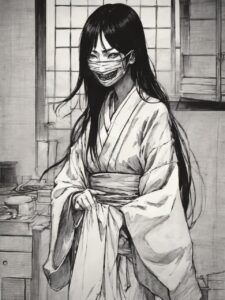
The physical description of Kuchisake-onna, the Slit-Mouthed Woman, typically includes distinctive features that contribute to the eerie and unsettling nature of the legend. While there can be variations in different retellings, the common elements include:
Surgical Mask: Kuchisake-onna is often described as wearing a surgical mask that covers the lower part of her face. This mask may be used to conceal her disfigured mouth or to create a sense of mystery and unease.
Disfigured Mouth: The most iconic feature of Kuchisake-onna is her disfigured mouth. In the legend, her mouth is said to be slit from ear to ear, giving her a grotesque appearance. When she confronts individuals, she may reveal her disfigurement by removing the mask.
Long Hair: Kuchisake-onna is often depicted with long, dark hair. The hair may partially cover her face, adding to the eerie and ghostly imagery. Long hair is a common feature in many Japanese ghost stories and is associated with the yūrei, traditional Japanese ghosts.
White Dress: In some versions of the legend, Kuchisake-onna is said to wear a white or traditional Japanese dress. White is often associated with ghosts or spirits in Japanese culture, symbolizing death and the supernatural.
Eyes and Other Features: Descriptions of Kuchisake-onna’s eyes and other facial features may vary. In some versions, her eyes are said to be sinister or malevolent, while in others, they may be more human-like. The focus is often on the disfigured mouth as the central element of horror.
Personality
The personality of Kuchisake-onna is typically portrayed as vengeful and malevolent in the context of the urban legend. Here are some common aspects of Kuchisake-onna’s personality as described in the legend:
Vengeance: Kuchisake-onna is often depicted as seeking revenge for a perceived wrong or injustice that led to her disfigurement. In some versions, the legend suggests that she was the victim of a violent act, and her spirit returns to inflict harm upon others.
Inquisitive Nature: One of the central elements of the legend involves Kuchisake-onna approaching individuals and asking them questions about her appearance. The questions typically revolve around whether she is beautiful. Her reactions to the answers can vary, and a wrong response may lead to harm.
Malevolence Towards Children: In some versions of the legend, Kuchisake-onna is said to have a particular animosity toward children. She may target them as victims, adding an extra layer of horror to the story.
Relentlessness: Kuchisake-onna is often portrayed as relentless in her pursuit of victims. Once she targets someone, she may continue to pursue them until they are harmed or find a way to escape her.
Supernatural Abilities: Some variations of the legend attribute supernatural abilities to Kuchisake-onna, enhancing her menacing nature. This may include the ability to appear and disappear at will or to pursue her victims through supernatural means.
Tragic Backstory: While the core of Kuchisake-onna’s personality is vengeful, some versions of the legend include a tragic backstory that adds a layer of sympathy for the character. This may involve her being wronged by a person or society, leading to her transformation into a vengeful spirit.
Explanation of the Myth
The myth of Kuchisake-onna, or the Slit-Mouthed Woman, is a Japanese urban legend that has evolved over time. The story typically revolves around a vengeful spirit or ghost of a woman with a disfigured mouth. Here is an overview of the myth:
Origins: The origins of the Kuchisake-onna legend are not precisely known, but it gained prominence in Japan during the 1970s. The story likely has roots in earlier Japanese folklore and ghost stories, and it has since become a popular and enduring urban legend.
The Disfiguration: In the legend, Kuchisake-onna is often described as a woman who suffered a terrible fate, leading to her mouth being slit from ear to ear. The reasons for her disfigurement can vary, with different versions suggesting that she was the victim of a violent act or that she inflicted the wounds upon herself as an act of vengeance.
The Encounter: Kuchisake-onna is said to roam the streets, wearing a surgical mask to conceal her disfigured mouth. She approaches individuals, often children or pedestrians walking alone, and asks a question about her appearance. Commonly, she asks, “Am I beautiful?” or “Do you think I’m pretty?”
The Dilemma: The person who is questioned faces a dilemma in responding. If they answer “no,” Kuchisake-onna may reveal her disfigured mouth and ask the same question again. If they answer “yes,” she may then remove her mask to show the extent of her disfigurement, posing the question, “How about now?”
Escape Strategies: The legend often includes suggested strategies for individuals to escape harm from Kuchisake-onna. These may include offering her candy, answering her questions ambiguously, or finding ways to distract her.
Consequences: Depending on the response of the person questioned, the consequences may vary. In some versions, Kuchisake-onna may spare the individual, while in others, she may harm or even kill them. The legend creates a sense of fear and suspense as individuals navigate the encounter with the vengeful spirit.
Cultural Impact: Kuchisake-onna has become a prominent figure in Japanese popular culture, inspiring adaptations in movies, books, and other media. The eerie and unsettling nature of the legend, combined with its cultural and supernatural elements, has contributed to its enduring appeal and widespread recognition both in Japan and internationally.
Similar cratures to Kuchisake-onna around the world
La Llorona (Mexico and Latin America): La Llorona, or “The Weeping Woman,” is a legendary ghost in Hispanic cultures. She is said to be the spirit of a woman who drowned her children and is now condemned to wander, weeping and looking for her lost children. The story varies across regions.
Melonga (Korea): In Korean folklore, the Melonga is a ghostly woman who roams at night, wearing a traditional white burial hanbok. She is often depicted with a veil covering her face and may approach or harm those she encounters.
Kuchisake (China): Similar to Kuchisake-onna, Chinese folklore has a character known as Kuchisake, a ghostly woman who wears a mask and asks people if they think she is beautiful. Her appearance is unsettling, and her story shares parallels with the Japanese legend.
A-Li-Shan (Taiwanese Aboriginal): A-Li-Shan is a vengeful spirit in Taiwanese Aboriginal folklore. This female ghost seeks revenge for injustices against women, especially involving betrayal or mistreatment by men. Her appearance is often depicted as ghostly and malevolent.
Hone-Onna (Japan): While not identical, Hone-Onna is a supernatural creature in Japanese folklore, often associated with the yūrei (ghost) archetype. She appears as a beautiful woman but reveals a skeletal, corpse-like form when touched.
Pontianak (Malaysia and Indonesia): The Pontianak is a female vampiric ghost or spirit in Southeast Asian folklore. She is often associated with vengeance and may appear as a beautiful woman during the day but transforms into a horrifying entity at night.
FAQ
Who is Kuchisake-onna?
How does Kuchisake-onna approach people?
Wearing a surgical mask, she approaches individuals, asking if she's beautiful.
What happens if you answer "no" to Kuchisake-onna?
She may reveal her disfigured mouth and ask the same question again.
What if you answer "yes" to Kuchisake-onna?
She may remove the mask, revealing her disfigurement, and ask, "How about now?"
Are there ways to escape Kuchisake-onna?
Strategies include offering candy, answering ambiguously, or finding distractions.
What are common physical features of Kuchisake-onna?
She's described with a surgical mask, long dark hair, and a slit mouth from ear to ear.
Has Kuchisake-onna's legend spread beyond Japan?
Yes, adaptations and variations have gained international recognition in movies, books, and media.
Why does Kuchisake-onna wear a surgical mask?
What happens if you encounter Kuchisake-onna alone at night?
It can be particularly eerie; she's often said to appear in quiet, dimly lit places.
Is Kuchisake-onna limited to a specific time or place?
No, encounters can happen at various times, and her legend doesn't specify a particular location.
Does Kuchisake-onna target specific individuals?
She often approaches pedestrians, especially children, but encounters can be random.
Are there cultural symbols associated with Kuchisake-onna?
Yes, elements like the white dress and long hair align with traditional Japanese ghost story imagery.
How has Kuchisake-onna impacted modern Japanese culture?
The legend is ingrained in pop culture, influencing horror themes in literature, movies, and even urban planning.
Are there real-life incidents related to Kuchisake-onna?
No, Kuchisake-onna is a fictional character from urban legends with no basis in actual events.
Can Kuchisake-onna be reasoned with or appeased?
Some versions suggest offering her candy may lead her to spare you, but results vary in different adaptations.
Does Kuchisake-onna have a tragic backstory?
Some versions imply a history of betrayal or violence, contributing to her vengeful nature.
Is Kuchisake-onna always a malevolent spirit?
Yes, her encounters typically involve harm or a sense of impending danger.
What emotions are associated with Kuchisake-onna's legend?
Fear, suspense, and a feeling of unease are common emotions tied to the encounters with her.
Are there rituals or charms to protect against Kuchisake-onna?
Folklore suggests various protective measures, such as chanting specific phrases or carrying certain charms.
Does Kuchisake-onna only appear in traditional settings?
No, adaptations often place her in modern urban environments, adding a contemporary twist to the legend.
Is Kuchisake-onna always depicted as a woman?
Yes, the legend consistently portrays her as a female entity seeking revenge or unsettling those she encounters.
